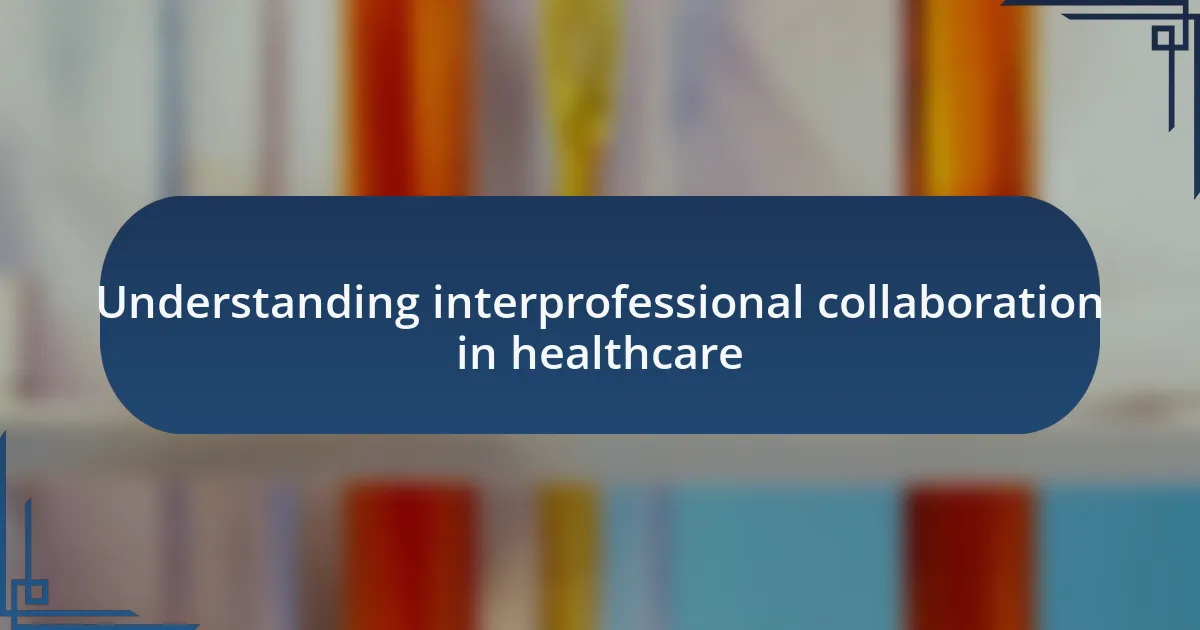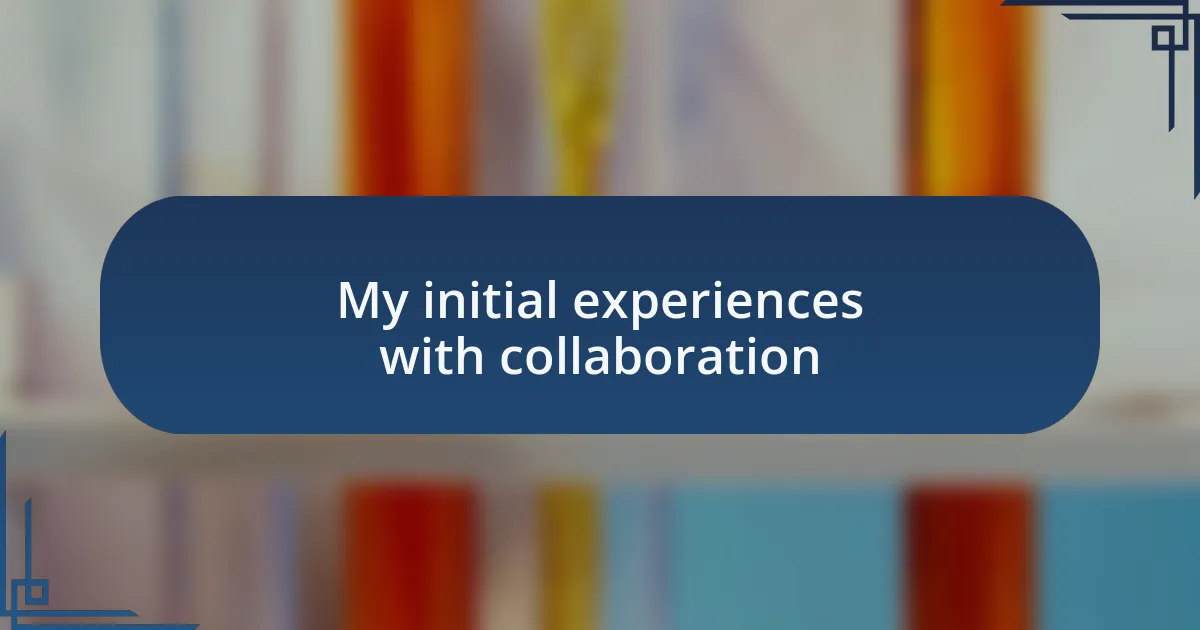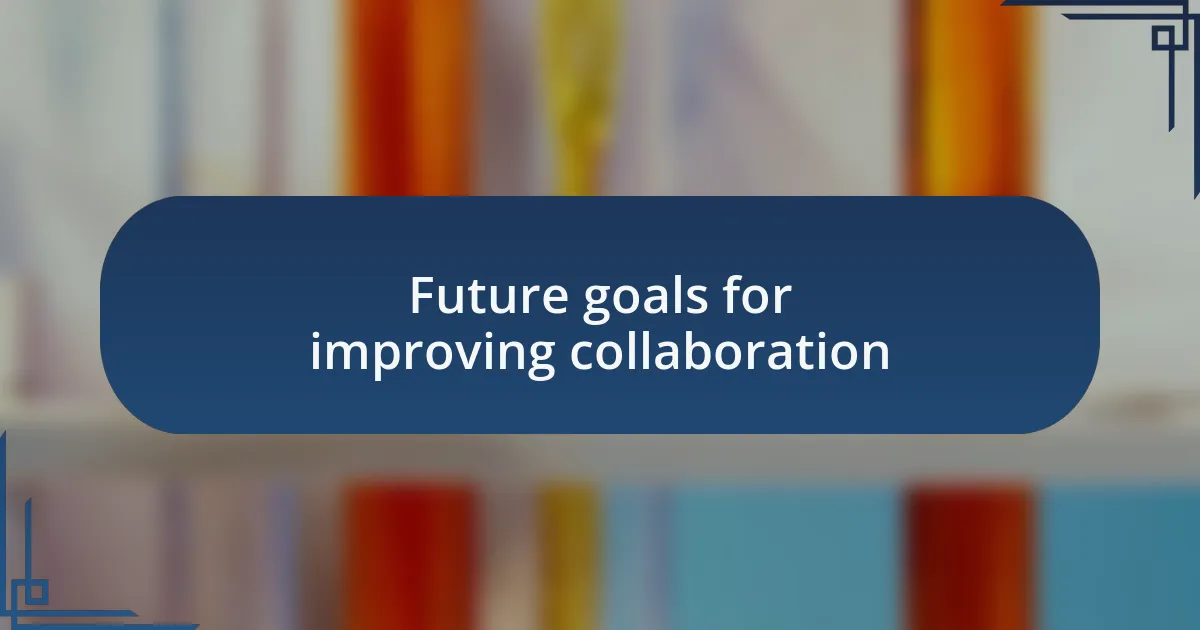Key takeaways:
- Interprofessional collaboration in healthcare enhances patient care by fostering a culture of respect and open communication among diverse professionals.
- Education on interprofessional collaboration is crucial for developing effective teams, promoting mutual understanding, and preventing misunderstandings in patient care.
- Challenges in collaboration include differing communication styles, dominating voices, and conflicting priorities, which must be addressed to improve teamwork.
- Building trust, reflective practices, and establishing shared goals can significantly enhance the functioning and outcomes of collaborative healthcare teams.

Understanding interprofessional collaboration in healthcare
Interprofessional collaboration in healthcare goes beyond just sharing a workspace; it’s about fostering a culture of respect and open communication. From my experience, when a team of doctors, nurses, and therapists comes together with a shared goal, the energy is palpable. Have you ever noticed how it feels when everyone is on the same page, working toward a common outcome? It’s invigorating and profoundly impactful for patient care.
Throughout my career, I’ve witnessed moments where collaboration turned challenging situations into opportunities. For example, I once observed a critical case where a patient was struggling post-surgery. The nursing team, concerned with the patient’s recovery, arranged a meeting that included the surgeons, physiotherapists, and dietitians. Watching them brainstorm solutions in real time showed me the power of diverse expertise coming together to create a more holistic approach to patient care.
Successful interprofessional collaboration hinges on mutual understanding and appreciation of each role’s contribution. I recall times when a simple “thank you” or acknowledgment from one professional to another made a significant difference in morale. This raises an important question: How do we foster such an environment? By actively valuing every team member’s input and celebrating collective victories, we can enhance not only patient outcomes but also our own professional satisfaction.

Importance of interprofessional collaboration education
The education surrounding interprofessional collaboration is vital because it lays the groundwork for building effective healthcare teams. From my own journey, I’ve grasped the significance of understanding different roles within a team. Have you ever wondered how a simple misunderstanding can lead to setbacks in patient care? Whether it’s a nurse misinterpreting a doctor’s orders or a therapist feeling overlooked in a treatment plan, thorough education can help prevent these issues by fostering mutual respect and clarity.
In one of my training sessions, I vividly recall a simulation exercise that thrust nurses, pharmacists, and social workers into real-world scenarios. The experience was electrifying; we tackled complex patient issues together. The camaraderie that developed made me realize that when education emphasizes collaboration, it not only enhances individual competence but also ignites a passion for shared goals. This kind of training is crucial because it prepares us to navigate the intricacies of patient care seamlessly.
Moreover, instilling a collaborative mindset during education shifts how future healthcare professionals perceive their roles. I remember a discussion where a medical student shared her fear of stepping on someone’s toes in a team. These fears can hinder participation, but through targeted training, we can empower students to assert themselves and contribute confidently. Isn’t it essential that we cultivate an environment where every voice is valued? Ultimately, interprofessional collaboration education equips us to celebrate diverse insights and work more harmoniously in the fast-paced world of healthcare.

My initial experiences with collaboration
The very first time I collaborated with other healthcare professionals, I felt a mix of excitement and anxiety. I remember being part of a case conference where doctors, therapists, and nurses came together to discuss a patient’s care plan. The atmosphere was charged with energy, but I quickly realized how every perspective mattered. That was eye-opening for me; it made me appreciate the value of listening to varied professional insights.
During my early experiences, I found myself in a multidisciplinary team meeting about a complex case. At first, I hesitated to share my thoughts, unsure if my fresh perspective as a novice would be welcomed. But when I finally spoke up and presented my ideas, it was incredible to see how my suggestions sparked further dialogue. That moment taught me that every voice in the room carries weight, regardless of experience, and how empowering that can be for all involved.
Reflecting on those initial collaborations, I often wonder how many emerging professionals hold back due to insecurities. I certainly did. It made me realize how critical it is to foster a supportive environment where everyone feels encouraged to contribute. By embracing collaboration, we not only enhance our learning but also transform how we approach patient care collectively, and that’s truly powerful.

Challenges faced in collaborative settings
In my experience, one of the biggest challenges in collaborative settings is navigating differing communication styles. I once participated in a team meeting where the physician and the nurse had contrasting approaches: one was direct and assertive, while the other leaned towards a more cautious and detailed explanation. This clash created tension and hindered the flow of our discussion. It made me realize that adapting to various communication preferences is crucial for effective collaboration.
Another hurdle I’ve encountered is the tendency for certain voices to dominate discussions. I remember a project kickoff meeting where one experienced member consistently steered conversations and overshadowed newer participants. As I sat there, I couldn’t help but feel frustrated. How can we tap into the diverse expertise within our team if some voices are unintentionally silenced? Creating an inclusive culture is vital for breaking down these barriers.
Finally, I’ve noticed that conflicting priorities often emerge as a challenge in collaborative environments. In a recent case, our team was divided on how to allocate resources due to differing departmental goals. The underlying tension between patient care and budget constraints was palpable. It led me to think: how can we better align our objectives to enhance teamwork? Addressing these conflicting priorities is essential for fostering stronger collaboration and ensuring our focus remains on the patient.

Lessons learned from teamwork experiences
One key lesson I’ve learned from teamwork experiences is the importance of building trust among team members. I recall a time when our group was tasked with a complex project, and I noticed that initial skepticism toward each other’s ideas was palpable. It wasn’t until we shared personal stories and vulnerabilities that we began to work cohesively. I realized that by fostering a safe space for open dialogue, we allowed creativity to flourish and innovation to emerge.
Another significant takeaway has been the need for continuous reflection on our collaborative processes. During a project debrief, I suggested we analyze what went well and what could improve. At first, there was resistance to critique, but when we uncovered blind spots in our workflow, the discussions shifted into constructive territory. This taught me that reflection is not just an end-of-project task; it’s a powerful tool for growth throughout the collaboration journey.
I’ve also observed that shared goals can unify a team, even in the face of challenges. I once worked on a multidisciplinary team where we all had differing opinions on our patient care approach. However, we agreed on a common objective: to ensure the best outcomes for our patients. This focus transformed our discussions from conflicts to collaborative problem-solving. It made me question: how often do we lose sight of our ultimate goal in the minutiae of duties? Focusing on shared objectives can indeed streamline our efforts and enhance our teamwork.

Future goals for improving collaboration
When I think about future goals for improving interprofessional collaboration, one aspect I find essential is ongoing training in communication skills. In my experience, clear and compassionate communication can often make or break a team’s effectiveness. I remember a time when we participated in a workshop focused on active listening. This training not only improved our interactions but also created a deeper understanding of each other’s perspectives. Why wait for conflicts to arise before honing these important skills? Building this foundation proactively can lead to smoother collaboration long before challenges emerge.
Another important goal is to integrate technology that supports teamwork. During a recent project, we used a collaborative platform that allowed us to share ideas and resources seamlessly. It felt like we were all in the same room, even though we were miles apart. The convenience and efficiency of this technology opened my eyes to the potential of digital tools in breaking down barriers. What if every team could tap into such resources? Imagining a future where technology enables real-time collaboration can inspire us to seek out innovative solutions.
Lastly, I feel passionate about having structured feedback mechanisms in place after each collaboration. Reflecting on past projects, I’ve noticed that when we had regular check-ins, it not only fostered accountability but also brought a sense of growth to our teamwork. There was a project where we implemented an anonymous feedback system, and the insights we gained were invaluable. Isn’t it fascinating how taking the time to reflect can enrich our experiences? Making feedback a regular part of our collaborative process will help us continually evolve and adapt to each team’s unique dynamics.